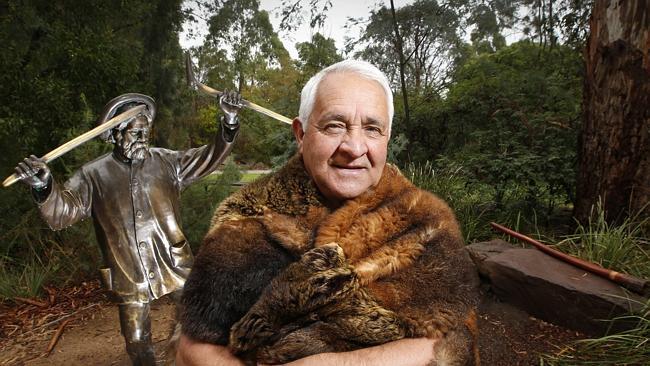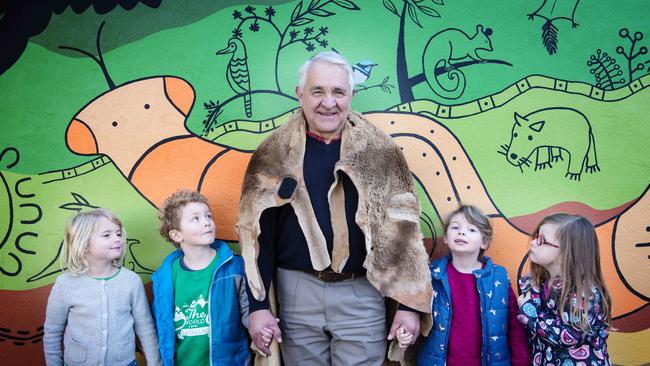Murrundindi passes on culture to thousands of kids
HE’S the spiritual custodian of land around Melbourne and Wurundjeri elder Murrundindi is on a mission to teach kids Victorian Aboriginal culture.

VIC News
Don't miss out on the headlines from VIC News. Followed categories will be added to My News.
AS THE elder or head man (Ngurungaeta) of the Wurundjeri tribe, Murrundindi is much more than the spiritual custodian of the land around the Melbourne region; his mission is to teach legions of Aussie kids about cultural ways, especially when they visit Healesville Sanctuary.
Murrundindi, 70, has an innate connection to the beautiful Badger Creek region around the famous sanctuary — his great-great-uncle is William Barak, the Wurundjeri elder and artist who worked to help create the self-sufficient Aboriginal farming station Coranderrk, now managed by Healesville Sanctuary.
Murrundindi’s mother and grandmother were born at the station, with its lush lake wetland and rich bush fringes, and he now takes tours of the land — being preserved as a remnant of intact bushland — to teach visitors to Healesville about the plants, animals, food and cultural practices of the Wurundjeri.
Being a head man and descendant of Barak — a police tracker and respected advocate of indigenous rights, whose face adorns the entire facade of the Portrait building on the old CUB site — brings responsibilities for Murrundindi. He is a guardian of culture and a vessel to pass it along.
“I’m spiritual custodian of the Wurundjeri tribal region; a teacher of the initiation, the ceremonial person. I put people through naming ceremony.
If there’s anyone out there who needs help or teaching I do that,” Murrundindi says.
He says Healesville’s name is no coincidence; as a traditional camping ground for Wurundjeri people, it has special qualities according to traditional lore.

“Healesville is a healing ground, that’s where my people lived,” he says. “If you’ve got any connection to the land and to the spirit you’ll understand it’s a healing ground.
“When I was young and going through difficult times and when I had illness, as soon as I got on to Healesville ground I was a completely different person.
“I go home (Tyabb) and play the didgeridoo and I’m not as good as when I get on to Healesville Sanctuary ground — it just hums for me.”
Murrundindi teaches visitors to the sanctuary about how native plants were used, including the leaves of the black wattle (which, when rubbed with water, make a strong soap-like suds for washing), the kangaroo apple (used as a dye and also eaten for medicinal effects) and golden wattle, whose seeds can be pounded into a flourlike powder to make damper.
He demonstrates and teaches boomerang throwing, and adds that his people were the only tribe to have comeback boomerangs.
“I didn’t have a strong white education but I had really good Aboriginal education from my mother,” he says. After his unusual birth, his mum believed Murrundindi would become an important teacher and told him so.
“When I was born, I was born in a sack of skin (with the amniotic sac still intact); my grandmother delivered me at home and said to my mother, ‘He’s been protected by spirits and he’ll be head man of the tribe when he grows up and he will be a teacher,’ ” says Murrundindi, whose surviving tribe now numbers only about 20 in his generation, and with their children, “maybe about 100 if we’re lucky”.
“I do believe I was chosen and gifted with my culture and I’m out there seven days a week presenting my culture. I’ve never had a sick day off, and been (at Healesville) over 30 years. If anything’s wrong with me I still go to work, if something does happen to me I seem to get better.”
He is also in high demand at many Melbourne schools, including Caulfield Grammar, Scotch College, Geelong Grammar, MLC, Camberwell Girls’ Grammar and Wesley, some of which take him on camp to teach students in the bush about the cultural significance of the flora, fauna and lore of their state.
Though numbers of his people have dwindled, Murrundindi says he likes to focus on the positives and is very heartened by rapidly increasing levels of interest in “our own” indigenous culture among Victorians.
“I had some people from (one) school up here and I was talking about foods and plants and what you can do with them, and they said, ‘Could you run a workshop for our parents?’ People are realising, ‘Why should we travel (to see other cultures) when we’ve got our own indigenous culture in our own back yard — let’s learn about it’,” he says. “People are reaching out for it.”
Do you know a country legend? Contact the Weekend editor at shelley.hadfield@news.com.au


